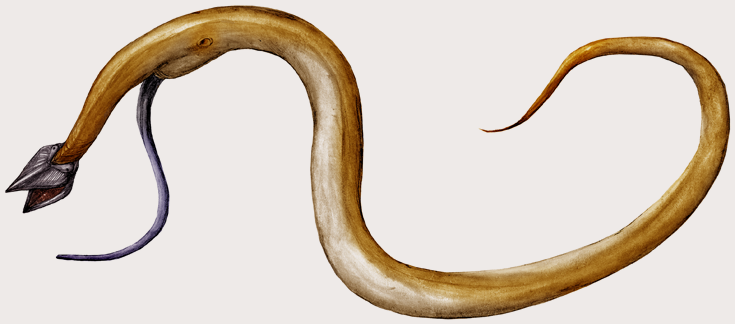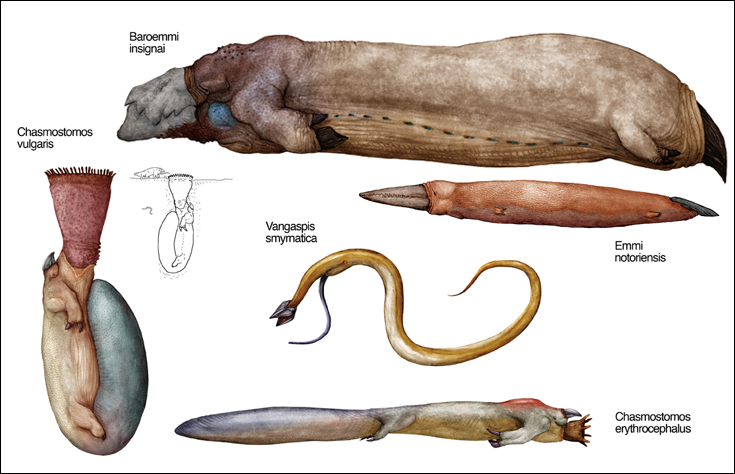"Sprogophidians"
The widespread presence of sprog; a spongy, hole-ridden, landscape-blanketing vegetative growth has given rise to a frustratingly large diversity of limbless or reduced-limbed snake-like creatures on Snaiad. Such creatures spend parts, if not all of their lives in sprog, sometimes also venturing to burrow in the soil lying beneath. This motley collection of burrowing creatures are thought to be related to each other and the grazing Lophophids, although the exact nature of these relationships is far from clear. They are loosely grouped together in the clade Sprogophidia, which might turn out to be paraphyletic. Notice that the Sprogophidian groups are far from being the only snake-like creatures on Snaiad; many other groups have independently evolved the same body plan.

Species: Chasmostomos vulgaris
Common Names: Common Pitmouth, Sausagetail.
Size: Females up to 25 centimeters including tail, males are smaller.
Habitat: Isternian coast-jungles, extending into mountain-forests along the Great Isternians.
Retaining all four feet, a clearly defined tail, head and eyes, the Chasmostomes are the most basal among all Sprogophidian clades. Nevertheless, they have some specialized features such as the fatty food reservoirs in their tails and their tentacle-rimmed second heads, which cannot be retracted back into the body. In the females of some species such as C. vulgaris, this structure has become a huge trap. While both sexes start out as ambulatory burrowing predators in leaf litter, sprog or soil, the females soon settle down in burrows and develop their mouths into their distended sizes. After settling down they feed entirely on Trikes, Picozoans, Softies and other animals they entice into their traps by the smell of rotting flesh. During lean times the females depend on fats stored in their equally distended tails, although they will still starve to death in a few weeks if no prey is captured. Because of this reason, these trapdoor Chasmostomes live only in jungles or forests, where a wealth of invertebrate prey is available year-round.
The males of this species are pretty “normal” looking with a mobile life style; their first heads conceal worm-like cranial genitals they use to burrow down to their mates’ concealed wombs.

Species: Chasmostomos erythrocephalus
Common Name: Sausagetail.
Size: About 20 centimeters with tail.
Habitat: Sprogland along the Eastern Plains to Pansavannah
This is a more “regular” species of Chasmostomos that is common in sprogland habitats rather than jungles. There are many (more than a hundred) related species like this one, they all live simple lives chasing small animals in sprog or other undergrowth, some species such as C. ammophilus also burrow under desert sand. They can shed their fatty tails when attacked, but it does not grow back once it is shed. Chasmostomes are important prey items for many small to medium sized predators in their respective habitats.

Species: Vangaspis smyrnatica
Common Names: V-Snake, Spadehead, Zilzal.
Size: Up to 30 centimeters in length.
Habitat: Neomediterranean maquis along the northern Neomediterranean shores.
Although this pale, snake-like creature is bland to the first look, its mysterious relationships make it highly interesting to Snaiadi biologists. Found only in the characteristic red maquis environment along the northern shores of the Neomediterranean, Vangaspis feeds on small animals it catches with its hose-like secondary head. Its first head bears a spade-shaped beak that seems to be used mainly for digging. Its body is serpentine and bears no trace of legs. Quite interestingly it has black blood, a characteristic unseen in other Snaiadi land animals.
What makes Vangaspis so interesting is that except from the two very similar species located under this genus, its lineage seems to have no close relatives. It is impossible to tell its closest relatives, but current consensus is that it forms a sister clade to all other Sprogophidians by itself. However, even this position might be revised as further research probes its identity, or fossils of related forms are discovered. Its taxonomically unique status and very limited distribution make Vangaspis one of the most precious of all Snaiadi animals.

Species: Emmi notoriensis
Common Names: Notorian Emmi, Red Emmi, Notorian Biter.
Size: About 30 centimeters long.
Habitat: Soil beneath sprogland and forest floor in the Notorian subcontinent.
The Emmiformes, with their tail-less, spike bearing backbones, bare, scissor-like beaks, and burrowing predatory habits form a group on their own within the Sprogophidia. Relatives of these creatures can be found in the Glacia-Notorian landmass as well as the main continents. This suggests that they are an old group that colonized these landmasses before they split apart. Emmis are vicious predators that burrow through earth, mud and sprog to capture their prey, which can be any of the numerous serpentine, burrowing creatures like themselves. Prey is dispatched and cut apart with the long, serrated beaks and then consumed by the prehensile second heads that normally lie concealed in their chests. Their backbones have a protruding spike, which not only gives them leverage when tunneling, but also helps them dig burrows backwards in substrate. This feature was used to suggest a relationship between the Emmiformes and the famed Fututors, which also bear pelvic spikes. However, later discoveries have thoroughly discredited this theory.
While some Emmis are tame when handled, the red Notorian Emmi is truly a vicious beast that bites, scratches, stabs and defecates explosively when picked up. Its bright color is thought to help it startle potential predators that might accidentally unearth it when digging around.

Species: Baroemmi insignai
Common Name: Megamouth.
Size: More than 1 meter long.
Habitat: Pansavannah
The Megamouth is the largest of all Emmiformes, almost three times larger and ten times heavier than its nearest competitor in size and mass. Not able to dig underground like its smaller relatives, this fat beast lives mostly as an ambush predator, hiding in a burrow carefully camouflaged under sprog and other growth. When a smaller animal walks by, it launches itself out of its hiding place, killing its prey with sledgehammer-like blows of its massive head. When larger animals such as Pneumagazelles (or people) pass by its nest, it might also seize a chance to suddenly grab their legs. While it has next to no chance of actually killing a Pneumagazelle, the Megamouth’s fearless attacks usually reward it with hefty mouthfuls of ripped flesh. Finally, at nights, it does not pass up the opportunity to crawl out of its nest and gorge itself on Fututor and Kahydron kills. In fact, it is not uncommon to find these animals nesting under fresh carcasses. Megamouths spend the desiccating Pansavannan summers in torpor, holed up in their burrows.
Baroemmi insignai is named after Jonas Insigna, the legendary Snaiadi zoologist who devoted his life to Snaiadi invertebrates, but also had plenty of time to study larger creatures on his field trips.
Copyright laws protect all intellectual property associated with Snaiad.
All artwork, concepts and names associated with this project belong to C. M. Kosemen, unless otherwise stated.
